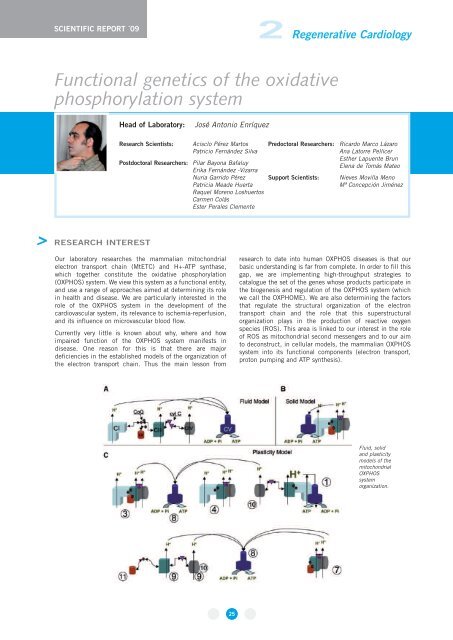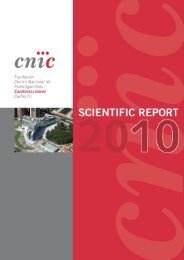Appendix - CNIC
Appendix - CNIC
Appendix - CNIC
Create successful ePaper yourself
Turn your PDF publications into a flip-book with our unique Google optimized e-Paper software.
SCIENTIFIC REPORT ´09<br />
> RESEARCH INTEREST<br />
Our laboratory researches the mammalian mitochondrial<br />
electron transport chain (MtETC) and H+-ATP synthase,<br />
which together constitute the oxidative phosphorylation<br />
(OXPHOS) system. We view this system as a functional entity,<br />
and use a range of approaches aimed at determining its role<br />
in health and disease. We are particularly interested in the<br />
role of the OXPHOS system in the development of the<br />
cardiovascular system, its relevance to ischemia-reperfusion,<br />
and its influence on microvascular blood flow.<br />
Currently very little is known about why, where and how<br />
impaired function of the OXPHOS system manifests in<br />
disease. One reason for this is that there are major<br />
deficiencies in the established models of the organization of<br />
the electron transport chain. Thus the main lesson from<br />
25<br />
2 Regenerative Cardiology<br />
Functional genetics of the oxidative<br />
phosphorylation system<br />
Head of Laboratory: José Antonio Enríquez<br />
Research Scientists: Acisclo Pérez Martos<br />
Patricio Fernández Silva<br />
Postdoctoral Researchers: Pilar Bayona Bafaluy<br />
Erika Fernández -Vizarra<br />
Nuria Garrido Pérez<br />
Patricia Meade Huerta<br />
Raquel Moreno Loshuertos<br />
Carmen Colás<br />
Ester Perales Clemente<br />
Predoctoral Researchers: Ricardo Marco Lázaro<br />
Ana Latorre Pellicer<br />
Esther Lapuente Brun<br />
Elena de Tomás Mateo<br />
Support Scientists: Nieves Movilla Meno<br />
Mª Concepción Jiménez<br />
research to date into human OXPHOS diseases is that our<br />
basic understanding is far from complete. In order to fill this<br />
gap, we are implementing high-throughput strategies to<br />
catalogue the set of the genes whose products participate in<br />
the biogenesis and regulation of the OXPHOS system (which<br />
we call the OXPHOME). We are also determining the factors<br />
that regulate the structural organization of the electron<br />
transport chain and the role that this superstructural<br />
organization plays in the production of reactive oxygen<br />
species (ROS). This area is linked to our interest in the role<br />
of ROS as mitochondrial second messengers and to our aim<br />
to deconstruct, in cellular models, the mammalian OXPHOS<br />
system into its functional components (electron transport,<br />
proton pumping and ATP synthesis).<br />
Fluid, solid<br />
and plasticity<br />
models of the<br />
mitochondrial<br />
OXPHOS<br />
system<br />
organization.



